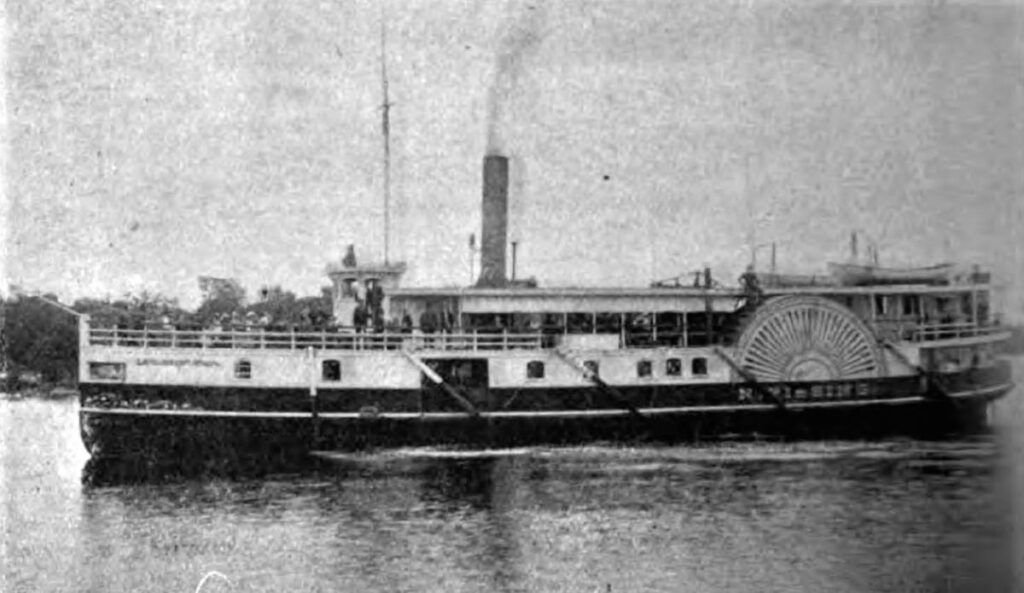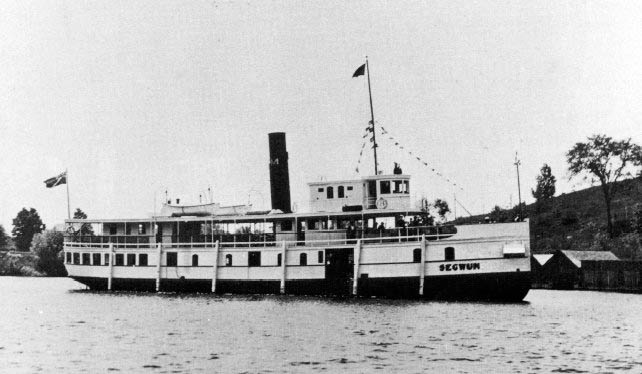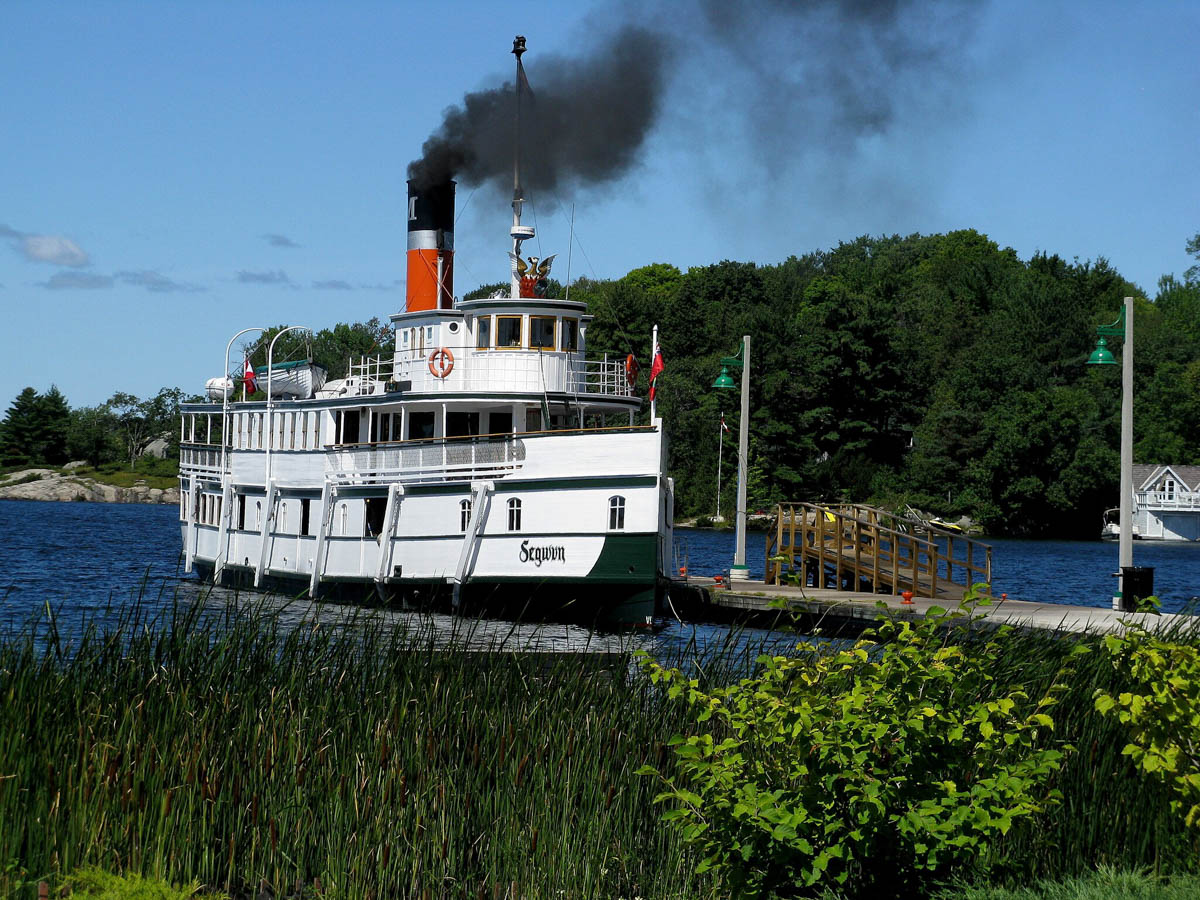“Muskoka’s steamship heritage is older than Canada. The first ship steamed Lake Muskoka in 1866.”
Muskoka Steamships and Discovery Centre
RMS Segwun is North America’s oldest operating steam-powered vessel, built in 1887 as Nipissing to cruise the Muskoka Lakes in Muskoka, Ontario, Canada, a resort area with numerous lakes and rivers. Muskoka had poor road access in the early twentieth century. Vacationers were transported to lodges or private cottages by a fleet of steamships. Segwun is the oldest and only steamer among the world’s three Royal Mail Ships. The ports of call were Gravenhurst, Bracebridge, Beaumaris, Port Sandfield, Port Carling, and Bala.
The Muskoka Lakes experienced significant tourism growth in the 1920s, as the Canadian economy recovered from the trauma of World War I. By 1924, the Muskoka Lakes Navigation Company realized that the six steamers that were then serving the lakes were becoming insufficient to the task and sought to expand their fleet. Rather than commissioning a completely new vessel, management decided to convert the decommissioned SS Nipissing from a paddle-wheeler to a twin propeller passenger ship. Nipissing’s wrought iron hull was built on the Clyde in 1887 and served on the lakes until 1915. Segwun was rebuilt on the hull of the second SS Nipissing. She was also converted from a side paddle wheel steamer to a walking beam engine.

The carving of the Phoenix on Segwun’s pilothouse is a replica of the one carried on Segwun in 1925. The first Phoenix statue was carved for a second version of the SS Nipissing, which was launched in 1887 to replace the original Nipissing, which had been destroyed by fire the year before. The new Nipissing inherited the engines from the original Nipissing, which had to be raised from the lake’s bottom following the fire, so the second version retained both the name and the steam engine. The SS Sagamo caught fire while being laid up at the end of the navigation season in 1925, so the Phoenix was placed on “the Sag” in subsequent years, where it was lost by fire again in 1969. The SS Sagamo was not rebuilt; however, the Phoenix rose from the ashes and is now carried by the ship for which it was designed.
The ship was launched in June 1925 to serve the summer passenger season. While she was originally intended to keep the Nipissing name, the Navigation Company decided to rename her Segwun, which is an Ojibwa word meaning “springtime”.
At the end of World War II, Major Hugh C. MacLean, publisher, sold his 90% interest in the Navigation Company to Gordon Douglas Fairley, a Toronto businessman. MacLean had owned a stake in the company for decades, and the steamship line benefited from promotion in MacLean’s publications. Perhaps anticipating a postwar economic boom similar to the 1920s, Fairley made significant investments in the company’s fleet.

Segwun was remodelled during the off season from 1946 to 1947. The gentleman’s lounge and two staterooms toward the aft of the upper deck were removed, and a new series of seven carpeted staterooms were built in their place, connecting to the forward oak-paneled lounge. The previously open space on that deck just aft of the stack was enclosed. In addition, a new steel bulkhead salvaged from Medora was installed in the forward hold to provide a crew sleeping area. The changes were generally favourable, but they increased the craft’s sensitivity to wind. These changes resulted in the ship’s silhouette that we still see today.
On September 16, 1949, a fire broke out on the SS Noronic, which was sailing the Great Lakes and docked in Toronto. Inadequate fire alarms and firefighting equipment allowed the fire to spread out of control, killing between 118 and 139 people. In the aftermath, the Ministry of Transport imposed new fire control requirements for steamships. The Muskoka Lakes Lines, then-owner of Segwun and the remaining steamships of the Muskoka Lakes Navigation and Hotel Company, was already struggling with declining passenger and freight business due to new competition from automobile and trucking lines, and lacked the resources to re-fit the entire fleet. The Muskoka Lakes Lines declared bankruptcy, and the ships were repossessed by the Navigation Company, which decided to install the necessary equipment only on the flagship Sagamo and her companion Segwun. Segwun was fitted with new hoses and hydrants and sailed during the 1950 season, but the Ministry reduced her occupancy certificate from 243 to 100.
Segwun was assigned a new captain in 1958 to replace the aging crew that had long manned the ship. Unfortunately, during his first trip, the captain hit the swing bridge at Port Carling, nearly disabling it, and then struck the concrete dock at the Lockmaster’s house, resulting in a badly dented forepeak. When roads were built, the majority of these Muskoka Lakes vessels were broken up or destroyed by fire. Segwun, along with the fleet’s former flagship, RMS Sagamo, were the last two remaining vessels in service when they were retired in 1958, and she spent decades moored at Gravenhurst’s Town Dock. In 1969, a fire destroyed Sagamo, which had been converted into a floating restaurant. The Segwun Steamboat Museum, located next to Sagamo, survived the fire.

Segwun was restored from 1972 to 1981 and reopened for service on June 27, 1981.Segwun retains its Canada Post ‘R.M.S.’ designation as an official Royal Mail Ship. As part of a fundraising effort, she once sold her own private label wine, which was distributed throughout Ontario by the L.C.B.O. Attractions Canada voted Segwun the ‘Best Large Attraction’ in 2001 and 2002.
Segwun now offers short sightseeing excursions, lunch, and sunset dinner cruises. She is owned and operated by Muskoka Steamships and Discovery Centre, a registered charity.





